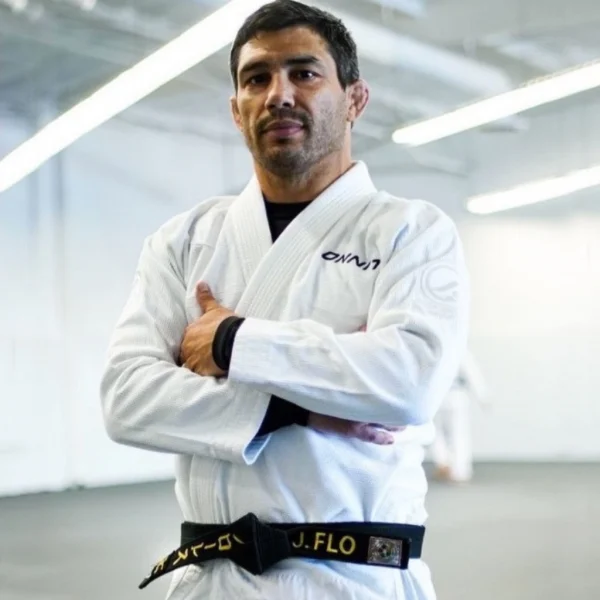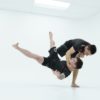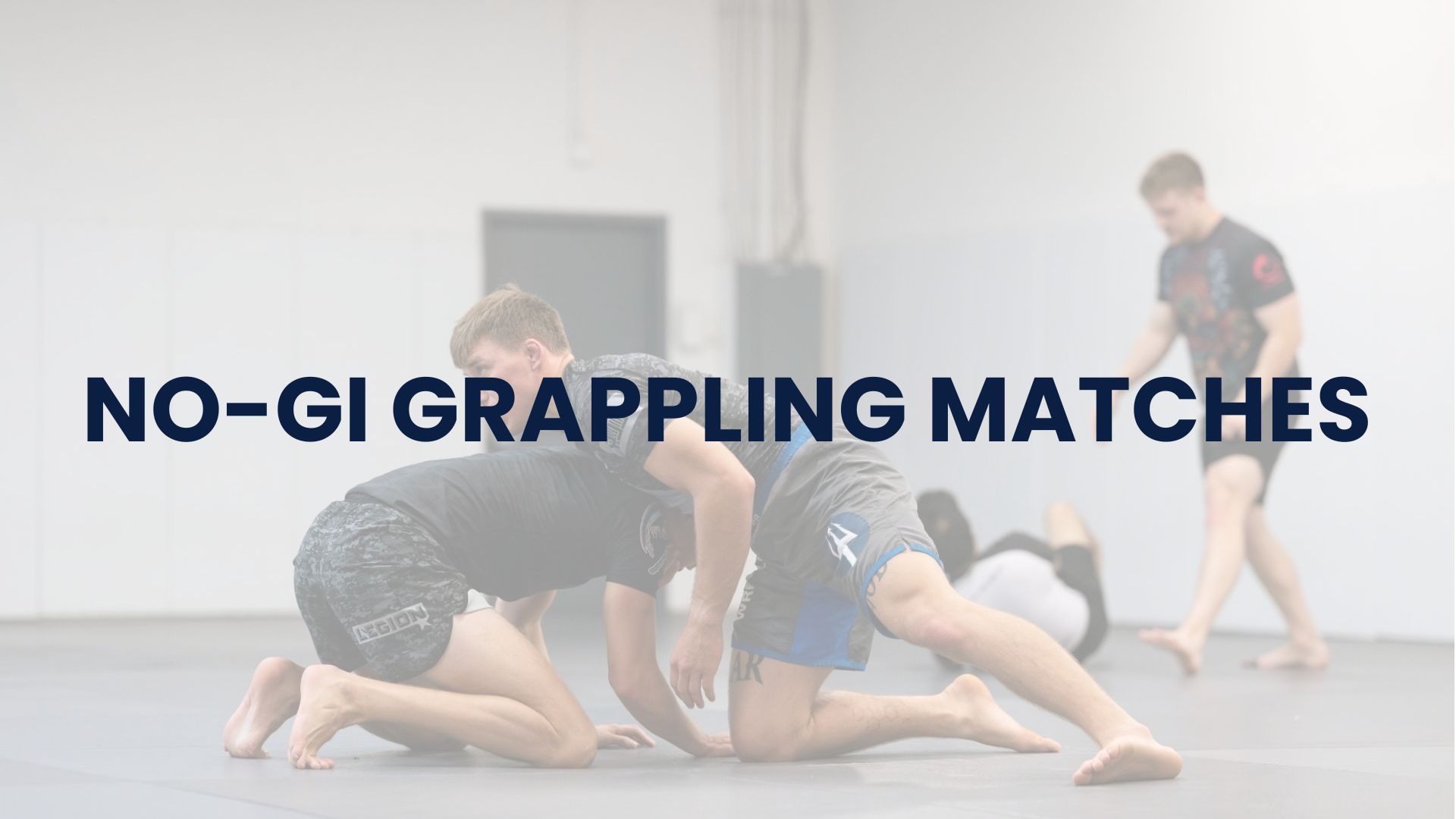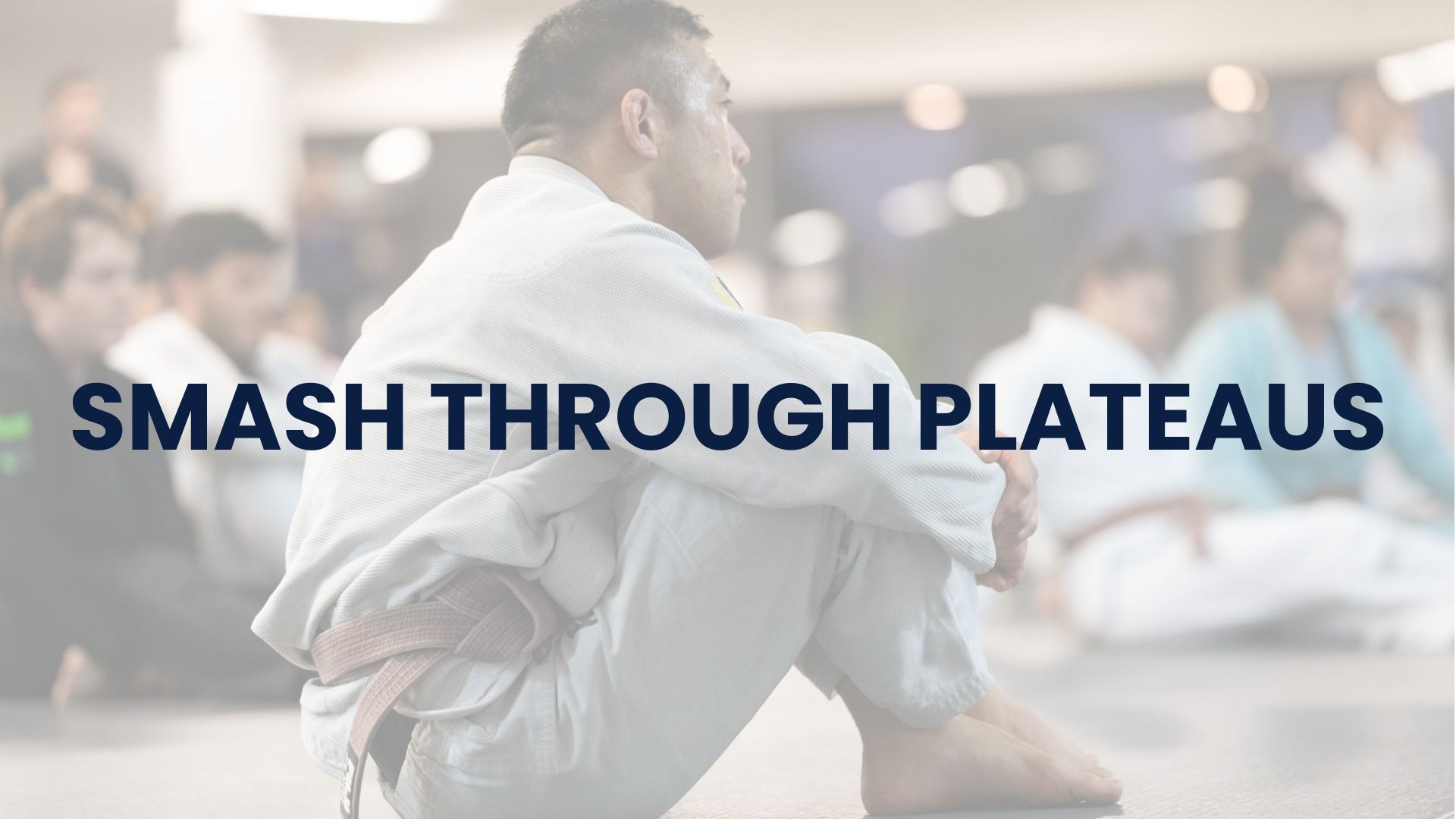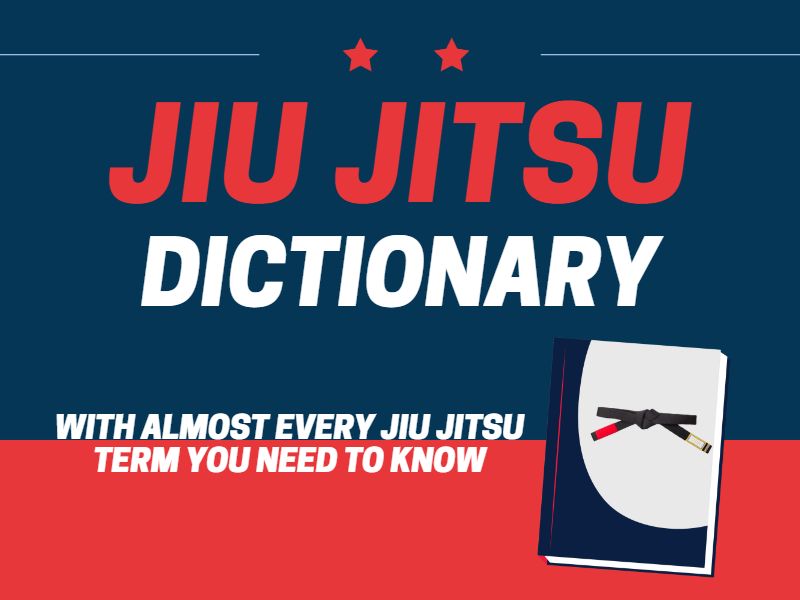Learn how to get better at jiu jitsu so you can stop running your head into that brick wall.
“Success is a few simple disciplines, practiced every day; while failure is simply a few errors in judgment, repeated every day.”
This quote by Jim Rohn sums up the basic idea behind today’s discussion.
It’s the results of the small, consistent decisions – or habits – that you make each day that compound over time and shape, positively or negatively, who you’ll become.
And the main idea here?…
… consistency is the KEY.
Making good decisions, like attending an extra training session each week, can really help you level up your game.
However, following those decisions through on a “time to time” basis will never be enough to move the needle.
The same is true for bad decisions.
Missing one night of training won’t be the end of the world, but missing a night of training each week for a period of 6 months absolutely can be the end of the world (according to your jiu jitsu).
Let’s do the math…
Assuming there are 4 weeks in a month, over a period of 6 months, your decision to regularly miss one or gain one more class a week could net you an extra ~24 classes or see you falling behind by ~24 classes over that 6 month period.
A small decision may not seem like much at first, but when combined with consistency, the compound interests are definitely significant.
Ok, so this isn’t what you would call, groundbreaking news, right?
You don’t need to be Russel Crowe in a Beautiful Mind to work the math on how many classes you could gain or lose over a period of time by your attendance practices.
However, in this article, I plan to show you how to apply a completely overlooked concept to your life with the power to potentially DOUBLE the results you would normally get from your decision making.
Double? Did you just say DOUBLE?!
F*$k yeah I did, and it’s through a little process called, improvement by subtraction.
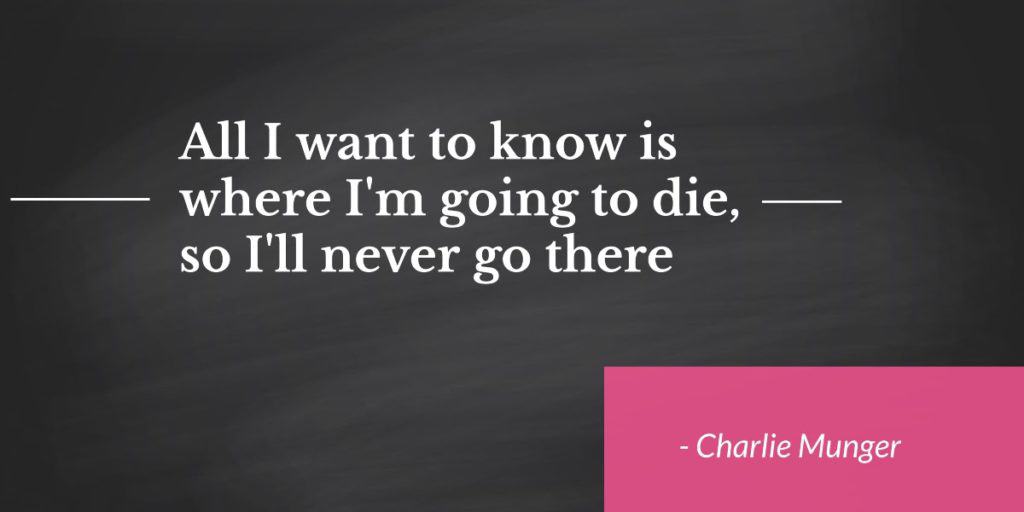
In a nutshell…
Improvement by addition = doing more of what works.
Improvement by subtraction = eliminating what doesn’t work.
Again, not quite earth-shattering, but bear with me, because I’m going to reveal something that may surprise you…
Let’s take a look at a couple of examples …
Improvement by addition – Things you can add to your week to help you get better at jiu jitsu
- Attending 5 classes per week; instead of 4.
- Drilling before class.
- Reflecting on performance in your journal after class.
- Working on mobility to reduce injury for 20 minutes a day.
- Packing your gym back the night before.
Improvement by subtraction – Things you can add to your week to help you get better at jiu jitsu
- Limiting weekly junk food intake.
- Figuring out why you got tapped instead of making excuses for why you got tapped,
- Never attend less than 4 classes a week.
(Note, I threw these together on a whim while waiting for the iced americano I just ordered at my local coffee spot. You will definitely come up with a longer list of better ideas to work for you. But these will do for our example.)
Now, looking at these potential options, you may think that the improvement by addition, would provide you with the biggest bang for your buck…
… and if you do, I have something to tell you that may surprise you.
Check out this graph sourced from jamesclear.com below…
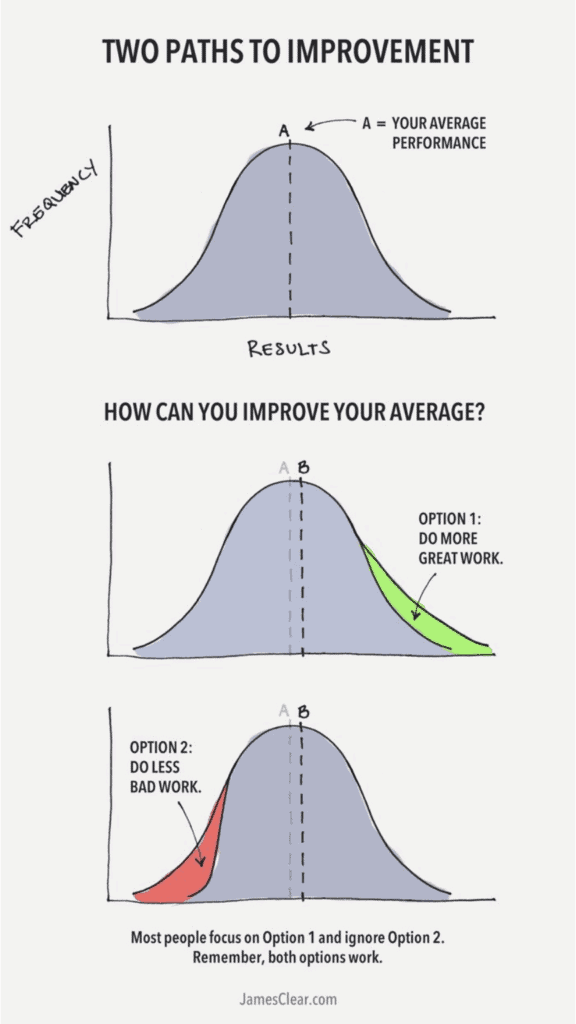
As you can see from the second bell curve above, a focus on improvement by addition: performing consistent positive actions; provides a benefit of potentially helping you improve your average peak performance from A to B along the x-axis.
However, the third bell curve shows us that a consistent reduction in poor actions also has the potential to move your average performance from A to B along the x-axis.
As you’ve probably guessed, a solid focus on both the addition of good decisions AND reduction of bad decisions from your daily routine is the key to DOUBLING your potential in jiu jitsu.
Now to the surprising part that I promised…
Which of the two processes for improvement – addition or subtraction – will provide you with the most efficient path to those improvements?
That is…
… which will help you move from A to B on the x-axis with relatively less effort?
Should you focus on doing more things better?
Or
Should you focus on making fewer easily avoided mistakes?
It’s natural to think that the only way to progress is to seek to improve on our actions and habits.
And the more effort spent “doing more”, the better the chances we have at achieving our goals.
It’s natural…
… but, it’s wrong.
Here’s why…
1. It’s much easier to recognize and eliminate poor actions than it is to master peak performance
The better you get at improvement by addition, the harder it is down the line to add more actions to return the same initial gains.
For example, say you have dynamite cardio – and can regenerate muscle tissue faster than Deadpool hooked up to an IV line full of stem cells. You’ve noticed that your weekly schedule of three classes per day six days a week just isn’t cutting it anymore so you decide to add an extra class to the seventh day.
Do you think that extra, 19th, class is going to give you the consistent bump in your development on the mats you’ve been looking for? More so than the previous classes were able to provide?
Now, let’s assume you’re a mere mortal like the rest of us, whose bodies tend to break down and become prone to injury the more physical stress is added and rest is reduced.
If your weekly class capacity was almost maxed, do you think going a step further and maxing out will give you adequate results; or do you think the risk of injury and slow reaction time, as a result of poor recovery practices, will end up sending you backward from your goals?
This is a concept known as the law of diminishing returns, which states that, after a certain point, adding more units of input will yield relatively smaller increases in output.

Note: The law of diminishing returns doesn’t technically include the negative returns as seen in the graph above; however, they are real and their likelihood is very important for you to consider in your development.
2. Improvement by subtraction means you are raising your baseline
The more poor actions you eliminate from your life, the less likely you are to sink to a point lower than your baseline.
And the higher your baseline, the more potential you have to develop on a consistent basis.

In the graph above, we have the probability of your daily performance indicated by the y-axis.
In this scenario, you regularly make a number of both good and bad decisions that significantly affect your peak and baseline levels.
How you perform on a given day will fall anywhere between these two lines.
Now, if you decide to actively reduce bad decisions from your routine, decisions that weigh heavily on your baseline, you may see your daily performance chart change to something more like this…
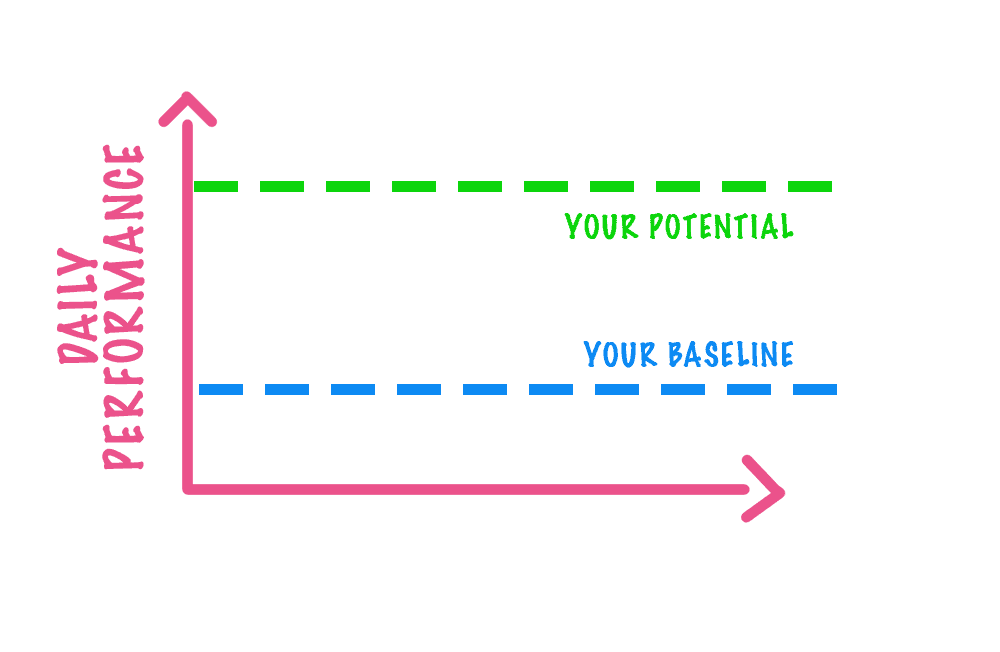
As you can see, reducing bad decisions will elevate your baseline and therefore narrow the probability of your daily performance potential: where your ability to perform closer to your peak potential, on a regular basis, is much more likely.
So, what are some examples of bad decisions you can eliminate to help increase your baseline?
Eliminating the use of your phone and other electronic devices late at night, so you can get a much more restful sleep, could be one.
Eating fast food one or two times less per week can help you avoid the consumption of excess calories (if consuming excess calories is a problem for you) and improve your daily wellbeing.
Ok, those are obvious, but what poor actions can you cut down on the mat to help you raise your baseline?
Let’s look at an example…
You make the decision to attend 5 classes per week, that’s one more than usual for you…
… but, you make excuses for getting tapped by the 16-year-old blue belt bermibolo kid in your class, instead of figuring out why you got tapped, and you trash them to the other people they’ve victimized on the mat, saying – “That sh*t wouldn’t work in the streets. Am I right?”
Then, one day, you realize that blue belt kid has taken your back 11 times in one week and choked you out in front of everyone. You still haven’t figured out how to stop it from happening and you’ve started to avoid sparring with them, coming up with weak excuses about your sore back or shoulder.
To make matters worse, others have seen this as your weak point and you’ve started to notice many of your friends drilling berimbolos before class and staring at you with hunger in their eyes…
… and now you’re avoiding them too. Eventually, the only people you’re left to train with are the day one white belts. I mean, hey, at least you can tep them out, right? Even if their stray elbows have glanced your eyebrows and groin one too many times.
But what if it didn’t have to be like that.
What if you made the commitment to eliminate this bad habit of trashing out the berimbolo kid behind their back to save your ego, and instead tried to figure out how to stop it.
Or even…
… asked for their advice on how to stop it.
Yes, residing under the comfort that is the shadow of your ego may feel good at the time, but letting this bad habit go will pay off tenfold by elevating your baseline and improving your daily potential.
And contrary to popular belief, letting go of your ego is an easy thing to do.
3. Improvement by subtraction is infinitely easier than improvement by addition
Once you reach the point of diminishing returns, it becomes so much harder to find those little things you can do to give you that edge.
And when you think about the upper echelon, the elite of the sport, and imagine yourself competing against them, simply thinking “I’ll outwork them” just won’t cut it….
… you’ve heard about the Miyao Brothers who lived on the mats and drilled and sparred with each other and their teammates from sunup to – well, sunup, haven’t you?
Are you going to magically add more hours to the day and make it 28 hours instead of 24? I’ll answer that for you, no, no you’re not.
However, while improvement by subtraction won’t solely jettison you into the ranks of jiu jitsu’s elite, the gains are there, and they’re relatively easy to achieve.
So, how can you use this information to boost your development and get better at jiu jitsu, right now?
Were going to take a leaf out of James Clears’ book here.
For the next 24 hours I want you to periodically write down all the actions you take in a day.
Take a minute or two every hour or so to write down what you did leading up to that interval.
After you’ve completed this task, I want you to take a piece of paper and draw a line vertically down the middle. Next, write eliminate on one side and optimize on the other.
Now, look at the actions you wrote down on the previous day and place all the poor actions in the eliminate section of the piece of paper and all the good actions in the optimize section.
Yes, there will be neutral activities performed that are neither good nor bad – they just ‘are’ – so don’t get hung up on trying to figure out whether dropping a deuce in the morning before or after brushing your teeth was a good action or a poor action, just mark it as neutral and move on.
Once you have your list, start making promises to yourself.
I will eliminate or cut down on XYZ each day.
I will continue to or double doing xyz each day.
Try this out and stick to your elimination and addition improvements for at least 30 days.
Once you’re done, feel free to tag us on Instagram in a post or in a story with your list and what you achieved.
We’d love to hear about them 😉
